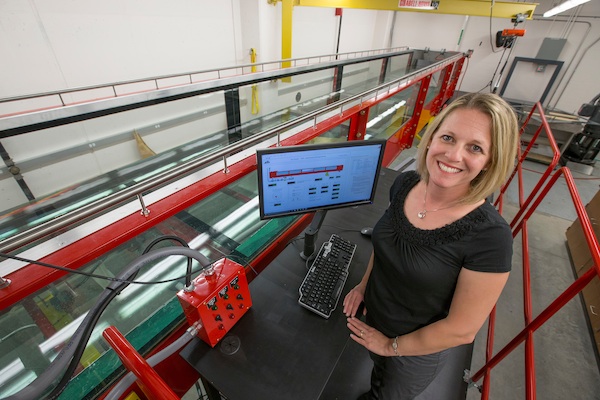
Facilities, faculty and staff bring Ag and Biosystems Engineering to #1
Facilities, faculty and staff bring ABE to #1
The U.S. News and World Report named Iowa State’s agricultural and biosystems undergraduate program number one among all national universities and first among public universities this September—a tie with Purdue University. Iowa State was ranked number two last year.
“The achievement of number one rankings was reached by dedication to the department’s mission and vision,” says department chair Steve Mickelson. “The department’s faculty, staff, graduate students, undergraduate students and scholars are all engaged in and committed to teaching, research, extension and outreach.”
The graduate program in agricultural and biosystems engineering (ABE) is ranked second in the nation. The Department of Agricultural and Biosystems Engineering is jointly administered by the College of Agriculture and Life Sciences and the College of Engineering.
“The department’s original mission was to mechanize agriculture,” says Mickelson. “That mission has evolved to encompass a global view of the entire food production system—the wise management of natural resources in the production, processing, storage, handling and use of food, fiber and other biological products.”
In the summer of 2014, ABE moved into its new state-of-the-art teaching and research facilities in the Biorenewables Complex at Iowa State University—Elings Hall and Sukup Hall and Atrium.
Fluid Learning
Brian Steward, professor of agricultural and biosystems engineering, challenges his students to name a piece of agricultural machinery that functions without hydraulics.
Most students struggle to come up with an example, emphasizing the importance of the fluid power teaching laboratory in Elings Hall.
Each hydraulic trainer workstation consists of a work bench, computer, electronic sensors and controls with a variety of valves and actuators. Over time, the custom equipment provided by Danfoss has become more state-of-the-art, which Steward says makes this lab the only one of its kind.
“We’ve continued to improve and add trainers for students,” says Steward. “While we were in Davidson Hall, we were limited by space and electrical capabilities. Our new building has helped us overcome those limitations. The lab is flexible, so we can arrange the trainers in a variety of ways depending on the class or research project. The added training units can accommodate more students in each lab section, thus increasing the quality and quantity of hands-on training in the lab.”
Steward states the majority of research done in the fluid power lab is student driven, through honors projects and special topics projects. It also has been used for industry short courses. In these two-day workshops, Steward teaches practicing engineers and technologists how to build and troubleshoot hydraulic circuits.
“Industry uses the same components we use in this lab, so this is not simply academic. This prepares students for the kind of problem solving they’ll experience in the real world,” says Steward.
Bringing water quality research indoors
The basement of the biorenewables complex is home to cutting-edge equipment, including a brand new hydraulic flume in the Buss Hydrology Lab. Researchers can program flow at various rates to simulate anything from sheet flow on a parking lot to high flow conditions in a stream.
“The flume brings unique control to the study of water flow we are not able to achieve in the field,” says associate professor Michelle Soupir.
The flume contains a sediment bed in which different soils or vegetation are placed to simulate stream bottom sediments, or flow through a buffer or wetland-type system. A sediment feeder is also part of the flume system allowing researchers to simulate water carrying a high load of suspended sediments. This makes the flume capable of meeting the varied research needs of environmental and engineering professionals.
“There are many ongoing discussions with faculty across campus about using the flume for research projects. We are also planning laboratory exercises for some of the upper level ABE environmental courses. I expect that we will also have graduate students work on the flume extensively for research projects,” says Soupir.
The water source for the flume comes from the storm water recovery system in the biorenewables complex, adding to the green features in the building. This gives researchers the option to use a natural water source instead of treated water and reduces impact on the environment.
“Dr. Manure” engages on social media
On campus and at extension field days he’s known as “Dr. Daniel Andersen, assistant professor.” He goes by a different name on social media – Dr. Manure (@Dr.Manure). Andersen uses his Twitter handle to engage with farmers, manure applicators and farm advisors to direct online traffic towards his blog, The Manure Scoop. The playful titles provide accessibility so that Andersen can discuss what’s really important, which is the science of manure.
“It’s about starting the conversation. Often people look at manure and think it’s a smelly waste product, but the truth is there are lots of options about how manure is handled and each of those decisions impact the value it has to our farming operation and its impact on the environment,” says Andersen.
As “Dr. Manure” he hopes he can create a greater understanding of manure, so people start changing the way they are make decisions about manure management.



